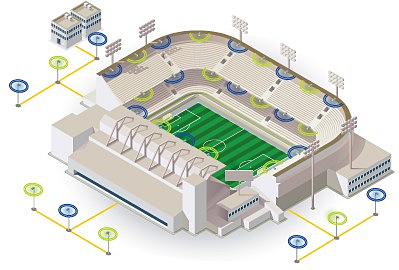The global public safety in-building wireless DAS market is estimated to grow from $404.2 million in 2016 to $1,740.1 million by 2021.
What Is It?
A Distributed Antenna System (DAS) is a network of antennae that communicate with a central hub to distribute signals over an area or building, such as stadiums, hospitals, campuses and airports. A DAS extends coverage across multiple antennae to provide coverage in all areas of a building, where signals could normally be degraded or dropped. In public safety applications, the central communication hub requires uninterrupted power to ensure emergency responders can communicate over the network.

Public Safety DAS Codes & Guidelines
- Equipment supporting a public safety radio system must be kept running on a battery backup for no less than 24 hours in the event of an emergency that results in power loss
- NFPA systems require 99% coverage in critical areas and 90% coverage in general-use areas; IFC requires 95% coverage in all areas
- System monitoring alarm codes mandate that alarms are generated at 70% remaining power (state-by-state basis)
How Does Tripp Lite Fit In?
A public safety DAS is only effective if it receives a constant, uninterrupted stream of power. In the event of a power failure, the system can go down, cutting off communication access. It is imperative that the central communications hub remains powered through power fluctuations and failures with a Tripp Lite UPS backup battery solution. Not only will this provide backup runtime to connected components, but equipment will also be protected against damaging surges and spikes that can cut an installation’s lifespan in half. The addition of an internal contact closure management card enables real-time monitoring and control of UPS conditions, status and alerts.
Next Steps
Tripp Lite offers 3 solutions specifically designed to provide reliable UPS battery backup and power management for DAS systems in the event of a power outage:
- 300W – 400W Applications
750VA/600W UPS System
24V 2U Battery Pack
Internal Accessory Card
- 500W – 1200W Applications
1500VA/1350W UPS System
36V 2U Battery Pack
Internal Accessory Card
- 1000W – 1800W Applications
2200VA/1920W UPS System
48V 2U Battery Pack
Internal Accessory Card





